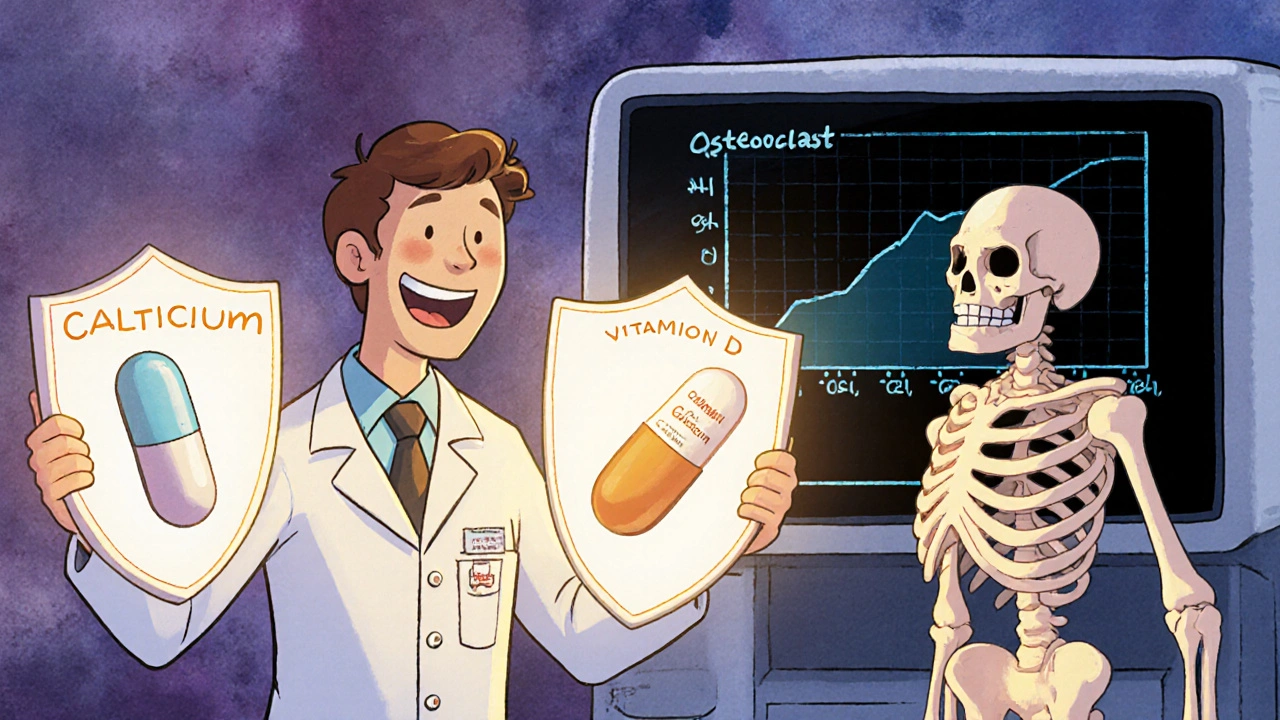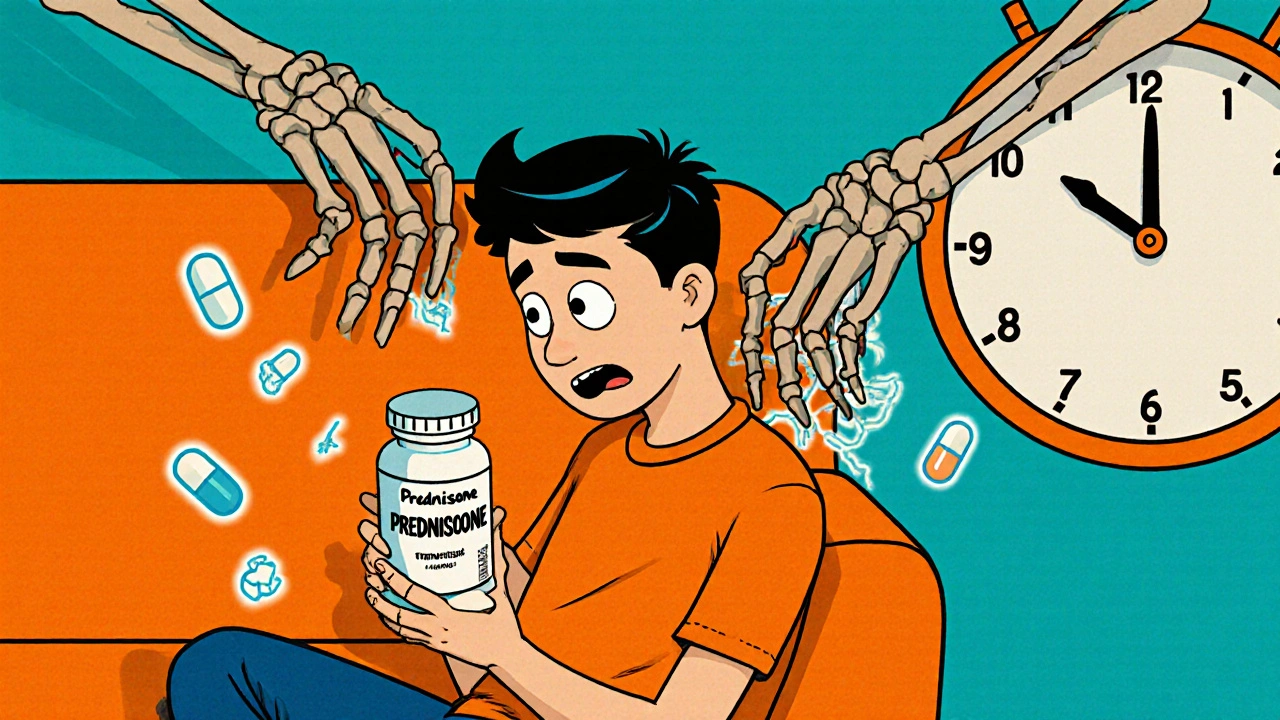Steroid-Induced Osteoporosis Treatment Calculator
Personalized Treatment Recommendation Tool
Enter your steroid therapy details to determine the best treatment options for preventing bone loss
Why Steroids Put Your Bones at Risk
If you’re on long-term steroids-whether for asthma, rheumatoid arthritis, lupus, or another autoimmune condition-you’re not just managing inflammation. You’re also silently weakening your bones. Glucocorticoid-induced osteoporosis (GIOP) is the most common type of secondary osteoporosis, affecting 30% to 50% of people who take these drugs for more than three months. And here’s the scary part: bone loss starts within just 3 to 6 months of starting treatment. Up to 12% of patients on doses of 7.5 mg or more of prednisone daily will suffer a vertebral fracture within the first year.
Unlike regular osteoporosis, which happens slowly as we age, steroid-induced bone loss hits fast. Steroids don’t just reduce calcium absorption-they shut down bone-building cells (osteoblasts) and ramp up bone-eating cells (osteoclasts). About 70% of the damage comes from suppressed bone formation, and 30% from increased breakdown. This dual attack makes GIOP especially dangerous. The result? A 5 to 17 times higher risk of breaking a bone compared to someone not on steroids.
The Foundation: Calcium and Vitamin D
Before you even think about pills that stop bone loss, you need the basics: calcium and vitamin D. These aren’t optional extras-they’re the minimum standard of care. The American College of Rheumatology says everyone starting long-term steroid therapy should get 1,000 to 1,200 mg of calcium and 600 to 800 IU of vitamin D daily. If your blood test shows you’re deficient in vitamin D (below 30 ng/mL), bump it up to 800-1,000 IU per day.
Calcium isn’t just about dairy. You can get it from leafy greens, fortified plant milks, canned sardines with bones, and supplements. But don’t just swallow a tablet and call it done. Take no more than 500 mg at a time-your body can’t absorb more. Spread it across meals. And always pair it with vitamin D. Without it, calcium just passes through you.
Real-world problem? Most people on steroids don’t get enough. A 2021 study of over 150,000 patients found only 19% were even prescribed these basics within three months of starting steroids. That’s not just negligence-it’s preventable harm. If you’re on steroids, ask your doctor for a blood test. If your vitamin D is low, fix it before anything else.
Bisphosphonates: The First-Line Defense
When your bone density is dropping and you’re on steroids for the long haul, bisphosphonates are your best bet. These drugs slow down bone breakdown and are the most studied, most used, and most cost-effective option. The American College of Rheumatology strongly recommends them for anyone over 40 taking 2.5 mg or more of prednisone daily for three months or longer.
Oral bisphosphonates like alendronate (Fosamax) and risedronate (Actonel) are the go-to choices. Take alendronate once a week-70 mg. Risedronate is 35 mg weekly. Both cut your risk of spinal fractures by 40-56%. In one trial, people on alendronate gained 3.7% bone density in their spine in just one year. Those on placebo lost 1.7%. That’s not a small difference-it’s life-changing.
But there’s a catch. These pills are picky. You have to take them on an empty stomach with a full glass of water. Stay upright for at least 30 minutes afterward. No lying down. No eating. No coffee. No antacids. Skip these rules, and you risk serious irritation in your esophagus. About 15-25% of people report this side effect.
And adherence? Terrible. Half to 70% of people stop taking them within a year. That’s why many doctors now offer zoledronic acid-an IV infusion given once a year. It’s just as effective at preventing fractures, avoids stomach issues, and boosts compliance. In one trial, patients on the yearly shot were 38% more likely to stick with treatment than those on weekly pills.

When Bisphosphonates Aren’t Enough
Not everyone responds the same. If you’ve already had a fracture, your T-score is below -2.5, or you’re under 40 with multiple risk factors, bisphosphonates might not be enough. That’s where teriparatide (Forteo) comes in.
Teriparatide is different. Instead of just slowing bone loss, it actually builds new bone. It’s a synthetic version of parathyroid hormone, given as a daily injection under the skin. In a major 2007 study, only 0.6% of people on teriparatide had a new spinal fracture over 18 months-compared to 6.1% on alendronate. That’s a 90% reduction in risk.
But it’s expensive. A month’s supply costs about $2,500 in the U.S., versus $250 for generic bisphosphonates. It’s also limited to two years of use. After that, your bones can’t keep responding the same way. And while it’s safe for adults, there’s a black box warning because it caused bone tumors in rats. No such risk has been seen in humans after 15 years of use, but doctors still avoid it if you’ve had radiation to the bones, Paget’s disease, or bone cancer.
Another option is denosumab (Prolia), a shot every six months. It reduces spinal fracture risk by 79% and is great for people who can’t take bisphosphonates due to kidney problems or stomach issues. But stop it suddenly, and you risk rapid bone loss. You need to switch to another drug carefully.
Who Gets What-and When
There’s no one-size-fits-all plan. Your treatment depends on your age, dose, duration, and fracture history.
- Everyone on long-term steroids: Start calcium and vitamin D immediately.
- Age 40+, taking ≥2.5 mg prednisone daily for ≥3 months: Add a bisphosphonate (oral or IV).
- Under 40 with prior fracture or T-score ≤-2.5: Consider teriparatide or denosumab.
- Severe kidney disease (eGFR <30): Avoid oral bisphosphonates. Use denosumab or teriparatide.
- Can’t tolerate pills: Go straight to yearly IV zoledronic acid.
Don’t wait for a fracture to happen. Get a baseline DXA scan (bone density test) when you start steroids. Repeat it at 12 months. If your bone density drops more than 5%, your treatment needs to change-fast.
What You Need to Know About Risks
Every drug has trade-offs. Bisphosphonates carry a rare but serious risk: atypical femur fractures and osteonecrosis of the jaw. These affect about 3-50 in 100,000 people per year. That’s extremely low, but it’s why doctors limit treatment to 3-5 years unless you’re at very high risk. After that, you might take a break or switch to another drug.
Teriparatide’s biggest downside? Cost and daily injections. You have to remember to inject yourself every day for two years. That’s hard for many. Denosumab requires strict timing-miss a dose, and your bone density can plummet.
And here’s the quiet truth: even with all this knowledge, most patients still don’t get the right care. One study found only 1 in 5 people on steroids had a bone density scan within the first year. That’s not just a gap in care-it’s a public health failure.
What’s Next? New Options and Better Strategies
The field is evolving. In 2022, the FDA approved abaloparatide-a newer injectable that may build bone even better than teriparatide. And researchers are now testing sequential therapy: start with teriparatide to rebuild bone, then switch to zoledronic acid to maintain it. Early results suggest this combo could increase bone density by 25% more than using either drug alone.
But for now, the bottom line hasn’t changed. Calcium and vitamin D are non-negotiable. Bisphosphonates are still the workhorse. Teriparatide saves lives in high-risk cases. The goal isn’t perfection-it’s prevention. Every person on long-term steroids deserves a bone health plan. If you’re not getting one, ask for it. Your bones will thank you.



Peter Aultman
Just started prednisone last month for my asthma and this post literally saved me. I had no idea bone loss could happen this fast. I already asked my doc for a D test and got a prescription for calcium. Took the advice about splitting doses too - now I take 500mg with breakfast and dinner. Feels weird but way better than just chugging a giant pill.